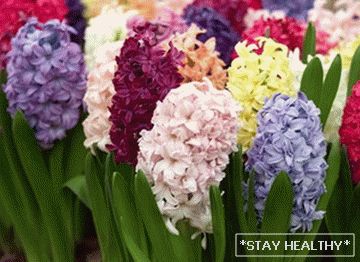 Fri, 04 Mar 2016
Fri, 04 Mar 2016
Род Гиацинт (Hyacinthus) относится к семейству
lily and includes about thirty species of plants that
grow mainly in the Mediterranean and South Asia. Most
The most famous of them is Oriental Hyacinth (Hyacinthus orientalis),
which place of growth are Greece, South Turkey, Syria
and Lebanon. You can often find blue hyacinths in southern Russia
(Hyacinthus leucophaeus) that are blue or white
flowers
Hyacinths were grown during the time of the Roman Empire. In Europe it is
the plant appeared at the beginning of the 16th century and immediately won love
privileged public thanks to its blue colors and
exquisite aroma. From the 17th century, hyacinths were bred in
industrial scale, and by the XVIII century there were about 2
thousands of varieties of plants. Even then, hyacinths had the most diverse
flowers: large fragrant, terry and simple, etc. Today
Major suppliers of hyacinth bulbs in Europe – the Netherlands and
Great Britain.
In early spring, these plants dissolve their bright and very
fragrant flowers, which can be white, pink, purple,
burgundy and even black. Hyacinth is a versatile flower,
suitable for cultivation both on the home window sill and in
the garden.
Contents
Hyacinth – growing and care
Hyacinths should be planted in solar or penumbra,
protected from wind sites. The soil on them should be light,
friable, with good water and breathability and
high content of humus. The plot should be flat and ideally –
have a small slope that would ensure the flow of water during thawing
snow in spring and during heavy rains in summer. Waterlogging and
the slightest flooding of the site can cause bulbs to die,
therefore, the groundwater level should be at least
50-60 cm. If they are closer, then drainage should be done or
do device bulk ridges.
After the end of the flowering period, the peduncle should be cut.
hyacinth as high as possible and allow the leaves to naturally turn yellow and
die off, in this case the beneficial substances get back into
plant bulb. You can mulch the soil right over the wilted
leaves with fresh compost, it will help and protect the floral
bulbs, and feed them, and improve the look of the flower garden.
Гиацинт – пересадка и breeding
In our conditions, hyacinths should be planted from late September to
the beginning of October. If you do this earlier, then they can go up and
die in the winter frost, if later – then they will not have time
for thorough rooting to freezing the soil, which also threatens
their doom. However, hyacinths are planted in early November, in advance
Insulate the flowerbed with leaves and protect it with a film from rain and snow.
The bulbs are buried by 15-20 cm, so that the distance
there was at least 15 cm between the plants. To ensure the best
flowering and larger inflorescence size added to each well
some fertilizer.
The hyacinth planting site should be changed annually because
pathogens and pests accumulate in the soil;
the effects of which the plant is very sensitive. Return to
the former site of landing follows not earlier than in 3 years. Also
Do not plant hyacinths in areas where they grew
other bulbous crops and plants that have in common with them
diseases.
The plot begins to prepare for planting in about two months,
so that natural shrinkage of the soil does not cause a break
growing roots in autumn. Since the depth of their penetration into
soil is up to half a meter, then tillage should also
produce deeply. Sand should be added to the clay soil.
peat, if necessary, make organic and mineral fertilizers
(As a rule, humus or rotted manure is applied per 1 sq. m.
from 10 to 15 kg). The introduction of fresh organics is not recommended to
the bulbs are not rotted. Also очень полезно добавлять в почву
wood ash and superphosphate.
Hyacinth is multiplied by children – small onions. Each
The adult bulb of the plant annually forms 3-4 children. Onion
need to be carefully separated from the maternal bulb during the summer period
rest plants and land in the ground at the end of the summer. 2-3 years later
such bulbs grow up and the plant begins to bloom.
Can be propagated by hyacinth and seeds, but in the amateur
horticulture is almost not practiced, since a new plant is not
will have maternal properties and will begin to bloom only after 5-6
years old.
Hyacinth – Diseases and Pests
With the wrong care for hyacinth, some
Problems. So, with excessive watering, insufficient lighting or
drafts his leaves turn yellow. If when watering the buds
water enters, they may not open. Lack of lighting in
the flowering period can lead to lengthening and lethargy of the leaves. If a
not provide the plant with a sufficient period of rest, then it can
slow down growth.
The reasons for the lack of colors can be several. So happens
due to landing on the distillation is not large enough bulbs;
keeping them at too high a temperature; hasty transfer
bulbs in the bright sun. If a в период покоя цветки содержатся при
too high a temperature that exceeds 4-5 ° C, then flowers
will be deformed.
Of the diseases, hyacinths are most often affected by yellow bacterial
the rot that turns the bulbs into mucus that has a sharp
unpleasant smell. In this case, diseased plants and bulbs
to be destroyed, and the fossa, where they were located – to pickle
5% solution of formalin or bleach. After this plant
можно сажать на этом месте только через несколько years old.





